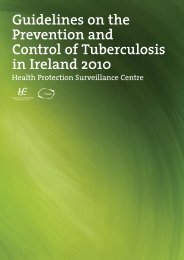Guidelines for the Early Clinical and Public Health Management of ...
Guidelines for the Early Clinical and Public Health Management of ...
Guidelines for the Early Clinical and Public Health Management of ...
Create successful ePaper yourself
Turn your PDF publications into a flip-book with our unique Google optimized e-Paper software.
<strong>Guidelines</strong> <strong>for</strong> <strong>the</strong> <strong>Early</strong> <strong>Clinical</strong> <strong>and</strong> <strong>Public</strong> <strong>Health</strong> <strong>Management</strong> <strong>of</strong> Bacterial Meningitis (including Meningococcal Disease)<br />
shared drinks with a case <strong>of</strong> IMD. They concluded that it is important to “distinguish between salivary contact <strong>and</strong><br />
respiratory droplet contact. Neisseria meningitidis colonises <strong>the</strong> posterior pharyngeal wall <strong>and</strong> is transmitted through<br />
respiratory droplets. In practice, some contact activities may involve both. For example, activities such as intimate<br />
(mouth-to-mouth) kissing are likely to involve both an important exchange <strong>of</strong> saliva <strong>and</strong> also an important exchange<br />
<strong>of</strong> respiratory droplets <strong>and</strong> have been linked to increased risk <strong>of</strong> carriage <strong>and</strong> disease. However, activities such as<br />
sharing drinks <strong>and</strong> cigarettes may occur in <strong>the</strong> absence <strong>of</strong> close contact.” The expert group reviewed <strong>the</strong> available<br />
evidence <strong>and</strong> made a weak recommendation that “Sharing drinks or cigarettes or similar contact with a case <strong>of</strong> IMD<br />
is not in itself an indication <strong>for</strong> chemoprophylaxis”. 2<br />
Recommendation regarding chemoprophylaxis in relation to salivary exposure:<br />
• Prophylaxis is not indicated <strong>for</strong> individuals who have had low risk salivary exposures unless already<br />
identified as close household type contact.<br />
• Prophylaxis is indicated <strong>for</strong> intimate mouth to mouth kissing contacts during <strong>the</strong> seven days be<strong>for</strong>e<br />
onset <strong>of</strong> illness.<br />
7.3.8 People exposed to a case while traveling.<br />
Transient contact with <strong>the</strong> index case be<strong>for</strong>e acute illness is unlikely to be an important risk factor <strong>for</strong> disease, so that<br />
mere proximity to <strong>the</strong> case (e.g. during travel in a plane, bus or car) may not justify prophylaxis. The ECDC guidance<br />
document – <strong>Public</strong> <strong>Health</strong> <strong>Management</strong> <strong>of</strong> Sporadic Cases <strong>of</strong> Invasive Meningococcal Disease <strong>and</strong> <strong>the</strong>ir Contacts 2<br />
reviewed <strong>the</strong> evidence <strong>and</strong> concluded that <strong>the</strong> quality <strong>of</strong> evidence <strong>for</strong> or against giving chemoprophylaxis to contacts<br />
who shared <strong>the</strong> same transport vehicle as a case <strong>of</strong> IMD is very low. The lack <strong>of</strong> clusters in <strong>the</strong> published literature<br />
suggests that <strong>the</strong> risk to contacts in <strong>the</strong>se situations is very low. The expert group reviewed <strong>the</strong> available evidence<br />
<strong>and</strong> made a weak recommendation that “Sharing <strong>the</strong> same transport vehicle as a case <strong>of</strong> IMD is not in itself an<br />
indication <strong>for</strong> chemoprophylaxis”. 2<br />
Recommendation regarding chemoprophylaxis <strong>for</strong> fellow travellers:<br />
• Prophylaxis is not indicated <strong>for</strong> those who shared <strong>the</strong> same transport vehicle (e.g. plane, boat, bus,<br />
car) as a case unless already identified as close household type contact.<br />
7.3.9. Post mortem exposure to a case<br />
The national document, “<strong>Guidelines</strong> on <strong>Management</strong> <strong>of</strong> Deceased Individuals Harboring Infectious Diseases”<br />
<strong>for</strong> publication in 2012 by a sub-committee <strong>of</strong> <strong>the</strong> Scientific Advisory Committee <strong>of</strong> HPSC 58 states that <strong>for</strong><br />
meningococcal disease “<strong>the</strong> risk <strong>of</strong> transmission from human remains in a funeral setting is extremely low”.<br />
There<strong>for</strong>e, in <strong>the</strong> case <strong>of</strong> meningococcal disease <strong>the</strong>re is no indication <strong>for</strong> precautions o<strong>the</strong>r than st<strong>and</strong>ard<br />
precautions in this setting.<br />
Recommendation regarding chemoprophylaxis following post mortem exposure<br />
• Post mortem contact with a case is not an indication <strong>for</strong> prophylaxis.<br />
• Kissing <strong>the</strong> body is not considered to be a risk. Body bags are not necessary unless o<strong>the</strong>rwise<br />
indicated, e.g. as a practical measure to facilitate lifting or moving. Transport to o<strong>the</strong>r countries <strong>for</strong><br />
burial or cremation does not pose a risk. There is no restriction on embalming.<br />
-61-

















